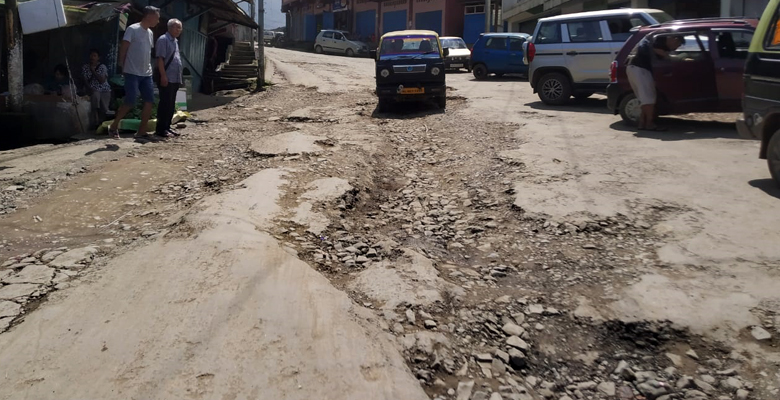This is a presentation made by the author at the Global Naga Forum (GNF) Commemoration of the 77th Anniversary of the Declaration of Naga Independence on 14th August 2024 on the topic ‘Socio-Economic Issues (Preparedness).’ Republished with permission.
Thank you moderators for the time, my co-panelists, my fellow Nagas and well wishers who has joined the celebration. It is a privilege for me to share some thoughts on “Socio-Economic Issues” on this auspicious day.
I appreciate that the Global Naga Forum (GNF) could come up with such pertinent issues to be discussed during such an important Day. This is probably another paradigm shift in our thinking that we also need to address other crucial issues facing the Nagas today.
Some may even allege that introducing “Socio-Economic Issues” during such an occasion would dilute or divert the Indo-Naga issue away from “the political issue”. But far from it, addressing the socio-economic issues will strengthen the movement. As Napoleon said, “An army marches on its stomach”.
For too long, we Nagas have either being ignorant of socio-economic issues or chose to ignore its importance. Most wars had been and are been fought over economic imperatives – though conveniently cloaked under the façade of “human rights” and “democracy”.
This subject requires a sound empirical data on both the people and the economy. Unfortunately reliable data on either, are seriously lacking. Socio-economic data published even by the State Governments are unreliable. Whereas this should be the basis for all economic planning either for the Government or the Private Sector.
Nagaland 2011 Census is still under litigation in the Supreme Court. A most peculiar situation. Ideally Census data should be updated annually, like in all advanced countries. But since 2011, 13 years later, we still don’t have a clear idea our own population status. When we inflate and distort our census figures for short term benefits for accessing higher village development funds based on number of households or for electoral gains, we are shooting ourselves in the foot. When census figures are distorted and becomes unreliable, a socio-economic analysis is really not possible. At best we can only do some extrapolations and assumptions. Left with no choice, I would have to do the same.
For instance, Japan did a 50-year plan for their socio-economic situation. By the 1980s itself they understood that their economy would be facing worker shortage due to a declining population. Thus by 1993, they had put into place the Technical Internship Training Program (TITP) for foreign workers in a controlled manner. By 2024 they have an estimated 2 million foreign workers. 2010 saw the year when their population actually started declining. Their 122.63 million population of 2024 is now less than that of 1990 population at 123.27 million.
Europe did not plan a similar strategy but relied on cheap mass migration to fill their labour market. We know where they have landed up. Nagas today face a similar situation. Visitors are surprised by how outsiders dominate our Trade & Business. Bangladesh has an unstated policy where they look at the lush green open lands of the NE Region and even beyond, as their lebensraum. If our social structure is destroyed by demographic invasion as it is going on today, and if our economy is controlled by outsiders, where is our socio economic survival and what purpose would political sovereignty do for a lost people?
With that scenario as the backdrop, let me try to speak on the Naga socio-economic situation. The Naga homeland is 1,00,000 sq.km (approx), with a Naga population of approximately 3.0 million (Nagaland 1.60m, Manipur 0.65m, Arunachal 0.16m, Assam 0.05m and Myanmar 0.30m).
Extreme BPL is defined as surviving on Rs 1,059/- per person per month (rural) and Rs 1,286/- (urban). As mentioned above, we do not have an accurate data on how much of Naga population is actually under BPL category. For Nagaland State NITI Aayog puts the figure at 58.80%, but some other estimates put it at 1.4million under BPL i.e. 87%. Whichever figure is the truth, it is an appalling situation that more than half of the State’s citizens are surviving under BPL status.
Global BPL is taken at $2.15 USD. The World Bank estimates India’s BPL as below:

The World’s Inequality Report states that the top 1% of the population in India made 22% of total national income, whereas the top 10% captured 57%.
India’s GDP (2024-25) is estimated at $4.15 trillion ($4,150 billion). Out of this, Nagaland’s GSDP (2024-25 projected) is $5.79 billion (Rs 48,375 cr.) and Manipur’s GSDP (2024-25 projected) is $ 5.42 billion (Rs 45,558 cr.).

If Nagaland was a sovereign country, our international per capita standing would be at 172 out of 180. Within India Nagaland and Manipur stands at 25 and 30 positions respectively out of 33.
If Nagas in Nagaland are at this unsustainably low position, Nagas in Manipur, Arunachal and Assam would be at least 2 times worse socio-economic condition. Nagas in Myanmar, without road connectivity, electricity, medical or education facilities would be 10 times or more worse off.
Unemployment Rate (UR): Another key missing parameter in State Government Economic Reports are unemployment rate. Nobody seems to know the real UR status in Nagaland. An article in the Morung Express dated 23.10.2023, carried a report, “During the period from July 2022 to June 2023, the unemployment rate in the 15 years and above category halved to 4.3%, as against 9.7% registered in the June 2021-July 2022 period. To provide context, this rate was 19.2% in 2020-21 and as high as 25.7% in 2019-20, earning Nagaland the unflattering distinction of having one of the highest unemployment rates among the States and UTs in India”. One is not aware of the methodology used to arrive at such figures, but an UR of only 4.3% is extremely unlikely.
Economists agree that an UR of 4-5% is a necessary evil for the job market. 8-9% becomes a crisis and 12-15% is an economic meltdown. In most societies social unrests begins by this threshold. My guesstimate is that the real UR for Nagaland would not be less than 20%. Maybe as high as even 30%.
Remember, I am using Nagaland as the reference point, where Nagas in Manipur, Arunachal, Assam and Myanmar would be much worse off. One of my co-panelist had mentioned about the hollowing out of church choir in her village in Ukhrul district of Manipur, because the youths are migrating out leaving the villages empty. I have said that most villages even in Nagaland are emptying out due to socio-economic reasons, and even our population could be declining. Its just that we do not have the data. We cannot blame the Government alone on this matter, as the people themselves are active participants in distorting the data for vested short-term interests.
Per capita consumption of electricity is another key parameter to indicate the industrial and socio-economic development and status of a country.

Under all the three key parameters for measurement of socio-economic development – per capita income, unemployment rate and per capita consumption of electricity, India is at the world’s bottom. Within that, Nagaland and Naga areas are again at the rock bottom. By all indicators, this is the classic symptom of a failed state. If Nagaland was a sovereign country, it would be no better than a banana republic.
Till the 1970s, Nagas economy was at subsidence level but had high resilience because our needs and wants were limited. Our pioneers had the patriotism and sense of sacrifice for the cause of the Nagas. Today its still at subsidence level, but our needs and wants has increased exponentially. This has induced very low resilience amongst our people and we have become susceptible to many compromises in almost every area. This creates disunity and fragmentation of our society, as each individual/group fight for the small cake. This is also one of the major drivers for the once undivided Naga movement to now fragmenting to dozens and counting.
Irrespective of whatever lip service may be given by our adversaries for socio-economic development of our land and our people, their strategy is to keep our land and our people underdeveloped and poor.
Again, we cannot and should not blame our adversaries alone for our socio-economic backwardness. We as a people has also proven to be stiff necked and often times, become the main obstacles for progress and development. Our ego, our struggle for narrow minded internal supremacy and misplaced priorities has become the key factors hampering our peoples’ development. Development, including all forms of physically tangible infrastructure development, starts from the mind. Our own narrow vested interests, either individual or village or even the tribe as a whole often comes in the way. We need an urgent change of mindset towards more openness and accommodativeness for changes and development for the greater common good.
Socio-economic Preparedness – the way forward
1. Most of our graduates are unemployable. Education therefore, from the school level to higher education, needs a total reform.
2. Education must also impart skills – both hard and soft skills. Tim Cook, CEO of Apple, “Apple is in China not because of cheap labour as some people may think. But it is because of certain specific skills sets that we need that is available in good numbers only in China” (paraphrased).
3. Looking at our 10+2 and UG degree graduates we can see that approximately 80% are from Humanities, 15% Science and 5% Commerce. This is too lop sided and unbalanced. During the last 4-5 centuries of history, we have seen that countries that led in technology led the world and its economy. We therefore need more STEM graduates (Science, Technology, Engineering and Mathematics). Here Government policy intervention is urgently required in the education sector.
4. We need reliable and accurate data and statistics, on all other relevant socio economic parameters, starting from the census. A basic sense of honesty starting from our own kitchens is the need of the hour.
5. We need to develop a Circular Economy.
6. We need Entrepreneurship with strong work ethics and dignity of labour. 7. All forms of Development starts with a changed mindset. We need to work on this.
The above sketch may seem like a pessimistic view. But its not. Its just holding the mirror for a realistic appraisal and see what course corrections can be done. Our land and our people has the resources and the potential for prosperity and success. The question is, how do we convert this rich potential to reality. The mirror and course correction can help.
Kuknalim
***
References:
i. Confessions of an Economic Hitman, John Perkins, Ebury Press London, 2005 ii. The American Trap, Frêdêric Peirucci, Hodder & Stoughton, 2019
iii. Strangers of the Mist, Sanjoy Hazarika, Penguin Books India, 1994
iv. Demand for Grants 2024-25, Government of Nagaland.
v. Survey Report on Local/Block Level Statistics for Local Level Planning 2020, Directorate of Economics & Statistics, Govt. of Nagaland.
vi. Economic Survey 2020-21, Directorate of Economics & Statistics, Govt. of Manipur.
Er Moa Aier



